- Home
- Carolyn Keene
The Secret of the Forgotten City Page 5
The Secret of the Forgotten City Read online
Page 5
She had soon scanned the first page and turned over to the next one. Suddenly she exclaimed, “Oh!”
“Bad news?” George asked.
“I don’t know,” Nancy replied. She pointed to a headline which read:RUMOR OF GOLD IN NEVADA DESERT RUSH TO SPOT EXPECTED
“Is it where we’re going?” Bess asked. “And do they mean the gold—”
George grabbed her cousin’s arm before she had a chance to give away their secret to anyone who might be snooping.
“Here’s a map of the area,” Nancy said, pointing it out in the paper.
The three girls studied it carefully and finally Nancy said, “Apparently it’s in the opposite direction from the one we’ll take out of Las Vegas.”
Bess sighed with relief. “Thank goodness. We’ve had enough trouble with strangers already.”
In a few minutes the boys rejoined the girls and Nancy showed them the newspaper story.
Ned whistled. “I hope none of the gold seekers come our way. That would spoil everything.”
As the group walked toward the boarding area, Nancy said suddenly, “What number are we? It’s like being in a maze. We’d better watch carefully for our sign.”
For a couple of seconds her friends said nothing. To an outsider Nancy’s conversation would seem perfectly rational. To her friends, using the third word in each sentence, she was saying, “Are being watch.”
One by one, members of Nancy’s group found an excuse to turn around completely to see who was watching them. All agreed upon a casually dressed young man. He seemed to be walking around aimlessly, but he always stayed close enough to hear as much of the young people’s conversation as possible. When he realized that they had detected his purpose, the man hurried away.
“One thing I’m sure of,” said Nancy, “is that he is not going on our plane. But he may want to make certain we’re aboard so that he can telephone the news to someone in Las Vegas.”
The trip to the Southwest was uneventful. On their arrival the young people taxied into the city in two cabs. They exclaimed over the garish downtown area.
“There must be billions of electric lights on these hotels, restaurants, and clubs,” remarked Bess, who was riding with Nancy.
It was a busy city, with taxis and private cars going up and down the streets in a steady stream. In a little while their cabs reached the residential area, which was very attractive and much quieter. The cabs pulled up in front of Neil Anderson’s home. It was spacious and had a beautiful flower garden.
Neil and his parents were charming people who made the visitors feel at home at once. A girl who was about fourteen years old came into the room and was introduced as Debbie, Neil’s younger sister.
“I’ll take you to your rooms,” she offered.
On the way through the split-level house, they passed the dining room. In it was a very long table set up as if for a banquet.
Debbie saw the looks of surprise on the visitors’ faces. “Big party here tonight,” she explained. “The rest of the Emerson group is in town and all the people going on the dig are coming here to dinner.”
“That’s great,” said Nancy. “Now we’ll be able to meet everyone. Debbie, I just can’t wait to see our caravan.”
“It’s pretty super,” the girl said. “I wish I could go on the dig, but they tell me I’m not old enough. I guess because I have so many little accidents, they think I don’t know how to be careful. I might ruin something precious that’s dug up.” She giggled.
“We’ll take lots of pictures,” Bess said kindly. “We’ll see that you get some.”
Since the dinner hour was only thirty minutes away, the young people quickly bathed and changed their clothes.
By the time they appeared, the other diggers had arrived. There were introductions, a lot of conversation, and a great deal of laughter.
Nancy was thrilled. What fun it was to join this jolly group and to try solving the mystery of the Forgotten City!
After dinner, the young people gathered in the garden. A graduate student from the University of Nevada, named Archie Arnow, immediately walked over to Nancy’s side to speak to her. At first she answered his questions lightly, but eventually she realized that he was trying to get information from her.
“I’ll pretend not to notice this,” she thought, giving him vague answers.
Several times Nancy tried moving away from him so she might talk to other people. He followed her very closely, and before she could say anything to her new friends, he would ask her another question.
“What a pest he is!” she told herself.
Nancy spotted Neil Anderson at one side of the garden. She made a sudden move, wedged her way through a group, and managed to get to Neil before Archie was aware of what had happened. Quickly Nancy asked Neil what kind of a person Archie was.
“Oh, he’s an archaeological whiz,” Neil replied, “but he’s not well liked. He’s very opinionated and secretive. Be careful, Nancy, or he may try to solve your mysteries for you.”
Nancy smiled. “Thanks for the tip.”
She said Archie had been following her around and asking questions. “I don’t know how much he has heard about what we’re going to hunt for out on the desert, so I thought it best not to tell him anything I knew.”
“You were wise, Nancy,” Neil said, “and you’d better warn your friends.”
Nancy alerted each one in her group.
George made a wry face. “I didn’t like Archie from the moment I met him. I wondered how you could be so patient, talking to him as long as you did.”
Nancy chuckled. “I couldn’t get away, but he didn’t learn anything from me.”
The following morning Nancy telephoned her home in River Heights. Hannah Gruen answered and told her that the police had phoned.
“They reported that Fleetfoot Joe had definitely left town,” she said. “McGinnis had phoned the Las Vegas police to be on the alert. So far he has heard nothing and suggested that if you should call, I should tell you to phone the police out there for information.”
Nancy did so at once but was told there was no news of the elusive thief.
As she left the phone, Nancy saw Ned coming toward her. She relayed her latest clue.
“Keep your eyes open,” he urged her.
Ned now told Nancy that he and the other boys would be busy the following day, helping to get the caravan ready.
“Is there anything we can do?” Nancy asked.
Ned shook his head. “Why don’t you girls go off and do some sightseeing in town?”
“I’d rather go out in the desert and visit the Lost City Museum.”
George and Bess were intrigued by this idea and immediately agreed to go with her. Nancy rented a car the next day and the three set off. The place was about fifty miles from Las Vegas and was situated in a desolate spot.
The museum was an attractive oblong tan stucco building. In front was a beautiful PaloVerde tree, which was unusual because everything about it was green—bark, stems, and leaves.
The girls were welcomed by a friendly man who said he was the curator. He offered to show them through the museum and explained that everything in it had come from the surrounding area.
“Are you girls interested in archaeology?” he asked.
“Yes we are,” Nancy replied. “In fact, we’re part of the group of diggers who are coming out to the desert tomorrow to work for a little while.”
The curator smiled and said he was glad to hear it. “Where are you going to locate?” he asked.
“Above the Forgotten City,” Nancy answered.
“Which one?” the man queried. “You know the Indian villages were strung along the Muddy River for some thirty miles. Of course, now they’re all buried. In fact, you wouldn’t believe it but four civilizations are buried in this territory.”
“Four?” Bess asked in astonishment.
“That’s right,” he said. “Their civilizations were built one on top of another. The to
p one was settled by people we here at the museum call the pit dwellers. This is because they built their dwellings or houses partially underground. Come outside and I’ll show you some that have been restored.”
He led the girls toward beehive-shaped clay huts. They were reddish tan in color. The visitors peered inside the first one. In the center of the floor were the remains of a fire.
“You see there’s a hole in the roof,” the curator explained. “The smoke went up through there.”
“How do you get in?” Bess asked. “There’s a doorway but no steps. Did the Indians jump down? I know from studies that they were rarely tall people.”
“They managed somehow,” the man replied. “But most of them entered through the roof. They climbed up a ladder to get there. Why don’t you step down inside? I think you can make it.”
Bess grabbed the sides of the doorway and put one foot down onto the floor. The next moment she skidded, turned her ankle, and went down in a heap.
“Oh, oh!” she cried out, pain creasing her face.
CHAPTER IX
The Weird Valley
INSTANTLY the curator jumped down through the opening and assisted Bess to her feet.
“I’m very sorry,” he said. “I should have stepped in first and helped you.”
By this time Nancy and George had come through the doorway.
“I see what happened,” Nancy said. “Here’s a little round stone. Bess, you must have skidded on it.”
She knelt down to look at Bess’s ankle, hoping it was not sprained.
“Let’s see if you can stand on it,” George suggested.
Bess found that she could but said it hurt to do so.
The curator spoke up. “My wife, daughter, and I live in the house connected to the museum. My daughter has had nurse’s training. Let’s see what she can do to help you.”
Bess put an arm around Nancy and George’s shoulders and hobbled on one foot back into the museum, then out onto a porch. Here it was shady and cool in contrast to the heat outside.
The curator went to get his daughter, who was very pleasant. In a short time she had bandaged Bess’s ankle tightly and the girl declared it felt much better.
“Bess, I suggest,” the young woman said, “that you leave the bandage on until you can ask a doctor just what the trouble is. My personal opinion is that it’s only a sprain.” The others were relieved to hear this.
Nancy and George felt that Bess should remain on the porch while they looked through the museum.
“Okay,” she agreed willingly.
The fascinating collection of relics in the museum included many different kinds of objects. There were arrowheads, stone spears, petrogylph tablets, bits of turquoise jewelry, pottery bowls, and scraps of baskets made from grasses.
“These baskets are probably the oldest things that have been found,” the curator said. “The Basket Makers belonged to the first civilization that was here.”
Nancy said, “Then some of the archaeologists have dug that deep?”
“It’s hard to say,” the man replied. “This basket might have been carried to this area in a stream, and picked up by someone from a later civilization. It’s very fragile. That’s why we have it behind glass.”
The girls spent a lot of time looking at each article.
Finally the man called to them. “I want you to see something special over here.”
They hurried to his side. He was standing beside a large case containing a complete human skeleton and many artifacts.
“This was a thirty-two-year-old woman,” the curator stated.
George remarked that the position of the skeleton seemed like a strange one in which to bury a person.
“It was the custom,” the man told her. “The Indians always buried their dead in the prenatal position.”
He told the girls that the cause of the woman’s death was a mystery. He looked at his visitors with a twinkle in his eye. “Perhaps you’d like to guess what it was?”
Nancy studied the objects in the case. Finally her eyes settled on a small stone plaque on which two sets of marks, one under the other, had been painted.
She said, “These lines are so jagged, they remind me of lightning. Is it possible that this woman was struck by lightninng and killed?”
“That’s a reasonable guess,” the man replied.
George, asked, “Do you have bad storms around here? I thought it rarely rained in the desert and that’s why it’s so hot and dry.”
The curator said she was partly right. “However, we do have thunderstorms and when we do, they’re dillies, let me tell you.” He grinned. “When you’re camping out in the desert, and one of those storms is coming up, you have to batten down good and stay under cover. The wind can be fierce, and sandy dirt and uprooted weeds blow all over the place.”
George asked if this was what was called tumbleweed, and did it actually roll across the desert?
“Some of it, yes,” was the answer.
The man excused himself, telling the girls to continue looking around. In a few minutes he returned with his wife. She was a smiling, motherly type of woman.
“We’d like to have you three girls stay to lunch,” she said.
“Thank you,” Nancy replied. “I’ll accept for all of us.”
She and George followed the woman out to the porch, where Bess and her “nurse” were sitting at a table. The others seated themselves. The curator said grace and Nancy was much impressed with his giving thanks for the works of the Deity, including the wonders of the desert.
Afterward he described the foods that might be found in the arid territory. “There are many uses for the cacti, even candy, and of course there are wild animals that can be shot and cooked.”
Bess remarked, “You have such a pretty garden. Where do you get water for it and for yourselves?”
“From an artesian well.”
Nancy was intrigued to hear this. So there was water deep under the surface. Maybe at some time this had been part of the Muddy River!
When there was a lull in the conversation, Nancy asked the curator if he knew Mrs. Wabash.
“Oh yes,” he answered. “A very fine woman.” He laughed and looked directly at Nancy. “She has a fantastic secret. Why don’t you ask her about it sometime?”
Nancy and George were afraid Bess might say something, but this time she kept quiet.
“I’ll do that,” Nancy said, deciding to ask the woman how much the curator knew.
He inquired, “Where are you going from here?”
Nancy said the girls planned to visit the Valley of Fire.
“Yes, do that. It is a fantastic place—one of nature’s great wonders. After you go to the Visitor’s Center there, ride on ahead for a little way and see the Mouse’s Tank.”
Bess giggled. “What a funny name! What is the Mouse’s Tank?”
The curator chuckled. “It was the hideout of a famous bandit.”
“With this bad ankle, that leaves me out,” Bess remarked.
“I’m afraid so,” the curator’s wife said, “You must climb to get there.”
The girls learned that at one time the area had been very wild, but now there was a good road leading to it, and a picnic spot had been built below the Mouse’s Tank.
When the group finished eating, the visitors thanked their host and hostess and their daughter, then drove off.
The three sightseers reached the first part of the Valley of Fire, where they looked around in awe, for they had never seen such an amazing sight. Enormous sandstone rocks were piled up, helter-skelter, to the height of a big hill.
Presently Bess cried out, “Look at that rock formation! It’s the perfect image of an elephant!”
They drove on a short distance, then George asked Nancy to stop. “See that strange formation up there! I want to get a picture of it.”
The rocks looked like three huge, perfectly formed birds’ claws, attached to part of a foot.
“This is like a
wild animal jungle turned to stone!” Bess exclaimed.
“It’s too bad we don’t have time to get out and walk among these rocks,” Nancy commented.
George returned to the car and a few minutes later asked Nancy to stop again. She pointed to a huge rocky mound surrounded by green ground cover.
“That rock looks just like a sleeping cow,” she said. “You can almost imagine that it’s going to get up soon and start grazing.”
Nancy had been silent for some time. Bess asked what she was thinking.
The girl detective smiled. “I was just trying to figure out this place. Perhaps once upon a time the area was fertile and huge beasts roamed around.
“One could almost imagine that there was a sudden volcanic eruption that tossed out rocks and a type of sandstone lava. The great beasts and birds were taken unaware and had no chance to escape. They died from the gas coming from the volcano.”
George looked at the girl detective. “Do you also believe the poor things turned to stone like a petrified tree?”
“Who knows?” Nancy countered. “The beasts might have been covered with lava that hardened. I suppose you’d have to crack the rocks open to see if there were any bones inside. Of course lava is so hot that it might have disintegrated the beasts’ whole body but left an outer coating.”
Bess sighed. “There are times, Nancy,” she said, “when your theories are way beyond me. I’m afraid this is one of them. Where do we go now?”
“To the Mouse’s Tank.”
The spot was deserted. The luncheonette-and-gift shop at the base of the rock was closed, and there were no cars around. Nancy parked and she and George got out.
“I’ll stay here,” Bess said. “My ankle doesn’t hurt, but I’d better not do any climbing.”
Nancy and George left her and walked forward. They were sorry no one was around to give them directions, but they finally found their way up to the entrance of the bandit’s cave and walked in.
“This sure is spooky,” George remarked. “What a place for a hunted man to hide! I wonder how deep the cave is.”
Nancy reminded her that since they had not brought flashlights and it was late in the afternoon, they had better not walk very far inside.

 The Purple Fingerprint
The Purple Fingerprint The Picture of Guilt
The Picture of Guilt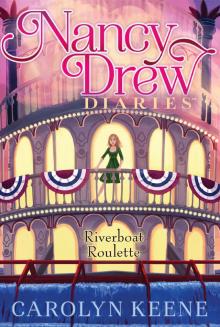 Riverboat Roulette
Riverboat Roulette The Singing Suspects
The Singing Suspects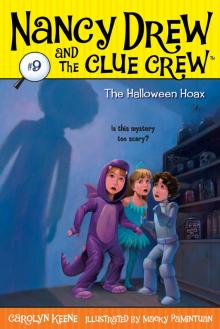 The Halloween Hoax
The Halloween Hoax 089 Designs in Crime
089 Designs in Crime The Hidden Treasures
The Hidden Treasures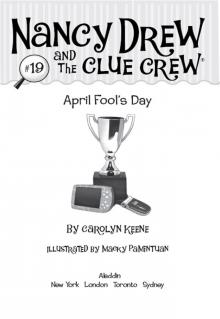 April Fool's Day
April Fool's Day The Black Widow
The Black Widow Final Notes
Final Notes The Haunting on Heliotrope Lane
The Haunting on Heliotrope Lane The Runaway Bride
The Runaway Bride The Ghost of Grey Fox Inn
The Ghost of Grey Fox Inn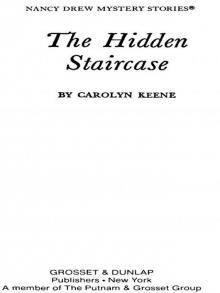 The Hidden Staircase
The Hidden Staircase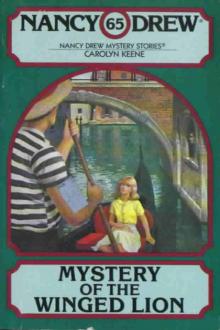 Mystery of the Winged Lion
Mystery of the Winged Lion Over the Edge
Over the Edge The Circus Scare
The Circus Scare The Mystery of the Brass-Bound Trunk
The Mystery of the Brass-Bound Trunk Ski School Sneak
Ski School Sneak Designed for Disaster
Designed for Disaster The Clue in the Glue
The Clue in the Glue Cold as Ice
Cold as Ice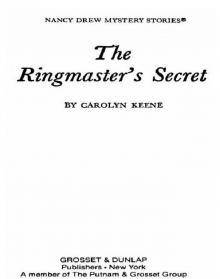 The Ringmaster's Secret
The Ringmaster's Secret 013 Wings of Fear
013 Wings of Fear The Secret of Shadow Ranch
The Secret of Shadow Ranch Not Nice on Ice
Not Nice on Ice Earth Day Escapade
Earth Day Escapade Mystery of Crocodile Island
Mystery of Crocodile Island The Bungalow Mystery
The Bungalow Mystery Power of Suggestion
Power of Suggestion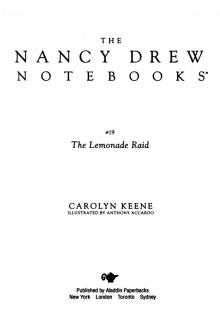 The Lemonade Raid
The Lemonade Raid Model Crime
Model Crime The Lucky Horseshoes
The Lucky Horseshoes The Secret of the Old Clock
The Secret of the Old Clock The Clue at Black Creek Farm
The Clue at Black Creek Farm Pure Poison
Pure Poison Nobody's Business
Nobody's Business Wrong Track
Wrong Track Chick-Napped!
Chick-Napped! Captive Witness
Captive Witness If Looks Could Kill
If Looks Could Kill The Mysterious Mannequin
The Mysterious Mannequin White Water Terror
White Water Terror Mystery of the Midnight Rider
Mystery of the Midnight Rider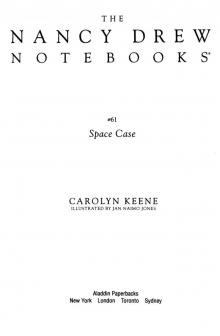 Space Case
Space Case World Record Mystery
World Record Mystery Hotline to Danger
Hotline to Danger The Red Slippers
The Red Slippers A Crime for Christmas
A Crime for Christmas A Musical Mess
A Musical Mess The Dollhouse Mystery
The Dollhouse Mystery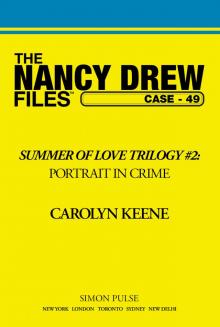 Portrait in Crime
Portrait in Crime The Message in the Haunted Mansion
The Message in the Haunted Mansion Playing With Fire
Playing With Fire Mystery of the Tolling Bell
Mystery of the Tolling Bell Cutting Edge
Cutting Edge The Gumdrop Ghost
The Gumdrop Ghost The Message in the Hollow Oak
The Message in the Hollow Oak Trial by Fire
Trial by Fire Mystery at Moorsea Manor
Mystery at Moorsea Manor Princess on Parade
Princess on Parade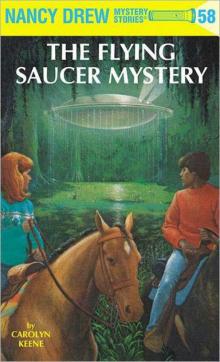 The Flying Saucer Mystery
The Flying Saucer Mystery 035 Bad Medicine
035 Bad Medicine 055 Don't Look Twice
055 Don't Look Twice The Haunted Showboat
The Haunted Showboat Out of Bounds
Out of Bounds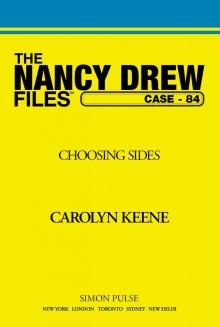 Choosing Sides
Choosing Sides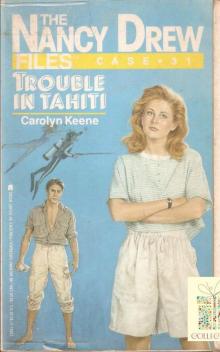 031 Trouble in Tahiti
031 Trouble in Tahiti The Suspect Next Door
The Suspect Next Door The Clue of the Black Keys
The Clue of the Black Keys The Secret Santa
The Secret Santa Race Against Time
Race Against Time 027 Most Likely to Die
027 Most Likely to Die The Cheating Heart
The Cheating Heart Dangerous Relations
Dangerous Relations It's No Joke!
It's No Joke! The Mystery of the Mother Wolf
The Mystery of the Mother Wolf 097 Squeeze Play
097 Squeeze Play Secret at Mystic Lake
Secret at Mystic Lake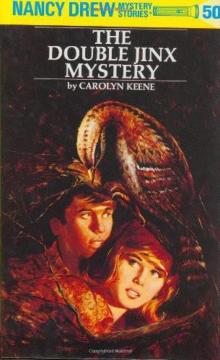 The Double Jinx Mystery
The Double Jinx Mystery The Walkie Talkie Mystery
The Walkie Talkie Mystery The Case of the Vanishing Veil
The Case of the Vanishing Veil The Mystery of the 99 Steps
The Mystery of the 99 Steps The Stolen Bones
The Stolen Bones The Clue of the Dancing Puppet
The Clue of the Dancing Puppet The Sand Castle Mystery
The Sand Castle Mystery A Model Crime
A Model Crime The Witch Tree Symbol
The Witch Tree Symbol The Case of the Artful Crime
The Case of the Artful Crime Mall Madness
Mall Madness Swiss Secrets
Swiss Secrets The Magician's Secret
The Magician's Secret Tall, Dark and Deadly
Tall, Dark and Deadly The Silver Cobweb
The Silver Cobweb The Clue of the Gold Doubloons
The Clue of the Gold Doubloons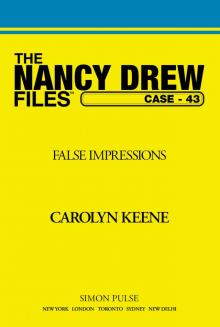 False Impressions
False Impressions Model Suspect
Model Suspect Stay Tuned for Danger
Stay Tuned for Danger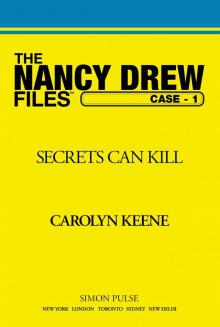 Secrets Can Kill
Secrets Can Kill The Bunny-Hop Hoax
The Bunny-Hop Hoax The Cinderella Ballet Mystery
The Cinderella Ballet Mystery The Secret at Solaire
The Secret at Solaire Trash or Treasure?
Trash or Treasure? The Missing Horse Mystery
The Missing Horse Mystery The Lost Locket
The Lost Locket The Secret of the Wooden Lady
The Secret of the Wooden Lady Password to Larkspur Lane
Password to Larkspur Lane Movie Madness
Movie Madness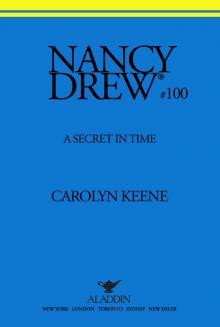 A Secret in Time
A Secret in Time The Twin Dilemma
The Twin Dilemma Candy Is Dandy
Candy Is Dandy Murder on Ice
Murder on Ice Dude Ranch Detective
Dude Ranch Detective The Slumber Party Secret
The Slumber Party Secret The Clue in the Old Stagecoach
The Clue in the Old Stagecoach Danger on Parade
Danger on Parade Big Top Flop
Big Top Flop Strangers on a Train
Strangers on a Train 087 Moving Target
087 Moving Target The Scarytales Sleepover
The Scarytales Sleepover The Mystery of the Fire Dragon
The Mystery of the Fire Dragon The Carousel Mystery
The Carousel Mystery The Eskimo's Secret
The Eskimo's Secret Thrill on the Hill
Thrill on the Hill 032 High Marks for Malice
032 High Marks for Malice Enemy Match
Enemy Match Poison Pen
Poison Pen Lights, Camera . . . Cats!
Lights, Camera . . . Cats! Lost in the Everglades
Lost in the Everglades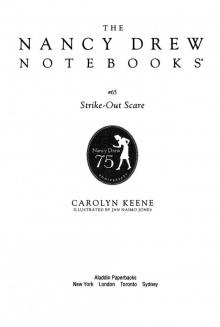 Strike-Out Scare
Strike-Out Scare Third-Grade Reporter
Third-Grade Reporter Sea of Suspicion
Sea of Suspicion Wedding Day Disaster
Wedding Day Disaster The Make-A-Pet Mystery
The Make-A-Pet Mystery The Ski Slope Mystery
The Ski Slope Mystery Pony Problems
Pony Problems Candy Kingdom Chaos
Candy Kingdom Chaos The Sign in the Smoke
The Sign in the Smoke The Wrong Chemistry
The Wrong Chemistry Circus Act
Circus Act Sinister Paradise
Sinister Paradise This Side of Evil
This Side of Evil Deadly Doubles
Deadly Doubles The Mystery of the Masked Rider
The Mystery of the Masked Rider The Secret in the Old Lace
The Secret in the Old Lace The Pen Pal Puzzle
The Pen Pal Puzzle Without a Trace
Without a Trace Whose Pet Is Best?
Whose Pet Is Best? Dance Till You Die
Dance Till You Die Trail of Lies
Trail of Lies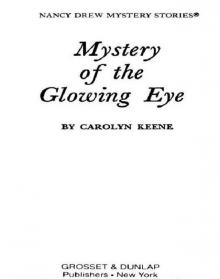 Mystery of the Glowing Eye
Mystery of the Glowing Eye The Clue of the Leaning Chimney
The Clue of the Leaning Chimney The Crook Who Took the Book
The Crook Who Took the Book Danger for Hire
Danger for Hire Thanksgiving Thief
Thanksgiving Thief Intruder!
Intruder!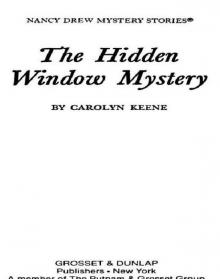 The Hidden Window Mystery
The Hidden Window Mystery Win, Place or Die
Win, Place or Die Danger in Disguise
Danger in Disguise The Best Detective
The Best Detective The Thanksgiving Surprise
The Thanksgiving Surprise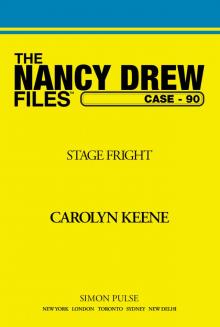 Stage Fright
Stage Fright The Kitten Caper
The Kitten Caper Stolen Affections
Stolen Affections The Phantom of Nantucket
The Phantom of Nantucket Date With Deception
Date With Deception Cooking Camp Disaster
Cooking Camp Disaster The Mystery at Lilac Inn
The Mystery at Lilac Inn Springtime Crime
Springtime Crime Action!
Action! Into Thin Air
Into Thin Air The Chocolate-Covered Contest
The Chocolate-Covered Contest 025 Rich and Dangerous
025 Rich and Dangerous Bad Times, Big Crimes
Bad Times, Big Crimes 078 The Phantom Of Venice
078 The Phantom Of Venice The Stolen Kiss
The Stolen Kiss Running Scared
Running Scared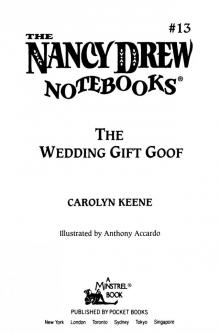 The Wedding Gift Goof
The Wedding Gift Goof Time Thief
Time Thief The Phantom of Pine Hill
The Phantom of Pine Hill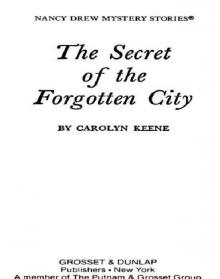 The Secret of the Forgotten City
The Secret of the Forgotten City The Emerald-Eyed Cat Mystery
The Emerald-Eyed Cat Mystery 004 Smile and Say Murder
004 Smile and Say Murder Curse of the Arctic Star
Curse of the Arctic Star Dinosaur Alert!
Dinosaur Alert! The Case of the Photo Finish
The Case of the Photo Finish Kiss and Tell
Kiss and Tell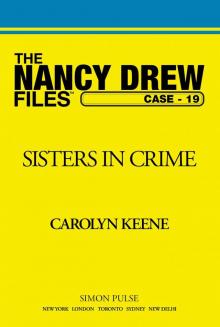 Sisters in Crime
Sisters in Crime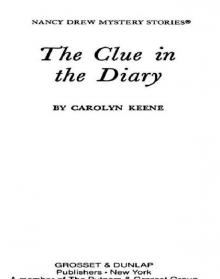 The Clue in the Diary
The Clue in the Diary 084 Choosing Sides
084 Choosing Sides Haunting of Horse Island
Haunting of Horse Island Vanishing Act
Vanishing Act The Big Island Burglary
The Big Island Burglary Danger at the Iron Dragon
Danger at the Iron Dragon Pets on Parade
Pets on Parade Something to Hide
Something to Hide The Strange Message in the Parchment
The Strange Message in the Parchment On the Trail of Trouble
On the Trail of Trouble Heart of Danger
Heart of Danger The Snowman Surprise
The Snowman Surprise Model Menace
Model Menace Flower Power
Flower Power The Great Goat Gaffe
The Great Goat Gaffe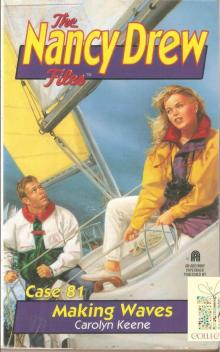 081 Making Waves
081 Making Waves Famous Mistakes
Famous Mistakes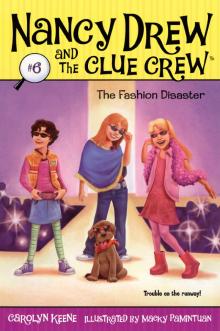 The Fashion Disaster
The Fashion Disaster The Clue in the Jewel Box
The Clue in the Jewel Box The Clue of the Whistling Bagpipes
The Clue of the Whistling Bagpipes Make No Mistake
Make No Mistake Greek Odyssey
Greek Odyssey Flirting With Danger
Flirting With Danger Double Take
Double Take Trouble Takes the Cake
Trouble Takes the Cake Turkey Trouble
Turkey Trouble The Day Camp Disaster
The Day Camp Disaster The Secret in the Old Attic
The Secret in the Old Attic The Baby-Sitter Burglaries
The Baby-Sitter Burglaries Recipe for Murder
Recipe for Murder The Secret of the Scarecrow
The Secret of the Scarecrow Cat Burglar Caper
Cat Burglar Caper Turkey Trot Plot
Turkey Trot Plot Scent of Danger
Scent of Danger The Clue in the Crossword Cipher
The Clue in the Crossword Cipher 010 Buried Secrets
010 Buried Secrets A Talent for Murder
A Talent for Murder The Triple Hoax
The Triple Hoax The Clue of the Velvet Mask
The Clue of the Velvet Mask Last Lemonade Standing
Last Lemonade Standing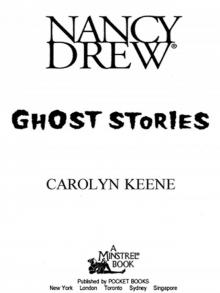 The Ghost of Blackwood Hall
The Ghost of Blackwood Hall The Black Velvet Mystery
The Black Velvet Mystery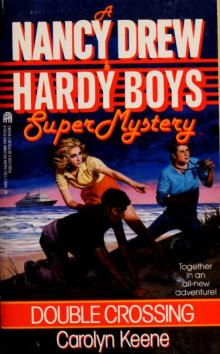 Double Crossing
Double Crossing Hidden Meanings
Hidden Meanings Trouble at Camp Treehouse
Trouble at Camp Treehouse An Instinct for Trouble
An Instinct for Trouble 037 Last Dance
037 Last Dance 038 The Final Scene
038 The Final Scene Duck Derby Debacle
Duck Derby Debacle The Pumpkin Patch Puzzle
The Pumpkin Patch Puzzle Hidden Pictures
Hidden Pictures Buggy Breakout
Buggy Breakout California Schemin'
California Schemin' Clue in the Ancient Disguise
Clue in the Ancient Disguise Case of the Sneaky Snowman
Case of the Sneaky Snowman 034 Vanishing Act
034 Vanishing Act A Script for Danger
A Script for Danger The Flower Show Fiasco
The Flower Show Fiasco Shadow of a Doubt
Shadow of a Doubt Easy Marks
Easy Marks Alien in the Classroom
Alien in the Classroom Ghost Stories, #2 (Nancy Drew)
Ghost Stories, #2 (Nancy Drew) The Bike Race Mystery
The Bike Race Mystery False Pretenses
False Pretenses The Kachina Doll Mystery
The Kachina Doll Mystery Designs in Crime
Designs in Crime False Notes
False Notes The Haunted Carousel
The Haunted Carousel Bad Day for Ballet
Bad Day for Ballet Very Deadly Yours
Very Deadly Yours The Fine-Feathered Mystery
The Fine-Feathered Mystery Circle of Evil
Circle of Evil The Crooked Banister
The Crooked Banister 005 Hit and Run Holiday
005 Hit and Run Holiday The Spider Sapphire Mystery
The Spider Sapphire Mystery The Swami's Ring
The Swami's Ring The Secret of the Golden Pavilion
The Secret of the Golden Pavilion Recipe for Trouble
Recipe for Trouble Betrayed by Love
Betrayed by Love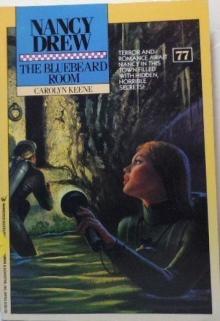 The Bluebeard Room
The Bluebeard Room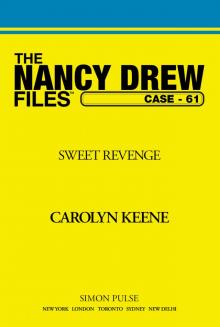 Sweet Revenge
Sweet Revenge Illusions of Evil
Illusions of Evil 006 White Water Terror
006 White Water Terror High Risk
High Risk Sleepover Sleuths
Sleepover Sleuths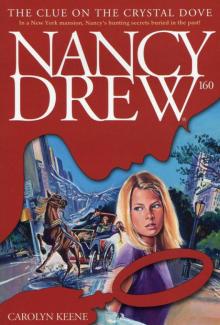 The Clue on the Crystal Dove
The Clue on the Crystal Dove The Stolen Unicorn
The Stolen Unicorn The Professor and the Puzzle
The Professor and the Puzzle The Elusive Heiress
The Elusive Heiress Stalk, Don't Run
Stalk, Don't Run The Mystery at the Moss-Covered Mansion
The Mystery at the Moss-Covered Mansion The Tortoise and the Scare
The Tortoise and the Scare 028 The Black Widow
028 The Black Widow Big Worry in Wonderland
Big Worry in Wonderland Crosscurrents
Crosscurrents The Dashing Dog Mystery
The Dashing Dog Mystery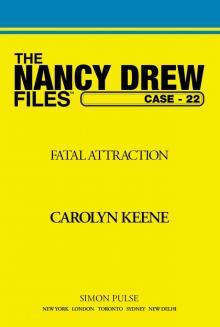 Fatal Attraction
Fatal Attraction The Clue of the Broken Locket
The Clue of the Broken Locket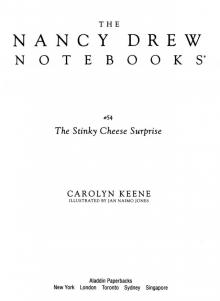 The Stinky Cheese Surprise
The Stinky Cheese Surprise Mystery of the Ivory Charm
Mystery of the Ivory Charm A Race Against Time
A Race Against Time Cape Mermaid Mystery
Cape Mermaid Mystery 085 Sea of Suspicion
085 Sea of Suspicion 058 Hot Pursuit
058 Hot Pursuit The Secret in the Spooky Woods
The Secret in the Spooky Woods The Mysterious Image
The Mysterious Image Fatal Ransom
Fatal Ransom The Stolen Show
The Stolen Show The Sinister Omen
The Sinister Omen The Secret of Mirror Bay
The Secret of Mirror Bay Rendezvous in Rome
Rendezvous in Rome The Perfect Plot
The Perfect Plot The Mystery of Misty Canyon
The Mystery of Misty Canyon Nancy's Mysterious Letter
Nancy's Mysterious Letter The Snow Queen's Surprise
The Snow Queen's Surprise The Clue in the Crumbling Wall
The Clue in the Crumbling Wall Dare at the Fair
Dare at the Fair Scream for Ice Cream
Scream for Ice Cream A Star Witness
A Star Witness 002 Deadly Intent
002 Deadly Intent Museum Mayhem
Museum Mayhem The Moonstone Castle Mystery
The Moonstone Castle Mystery The Whispering Statue
The Whispering Statue The Scarlet Slipper Mystery
The Scarlet Slipper Mystery Mystery at the Ski Jump
Mystery at the Ski Jump Hot Pursuit
Hot Pursuit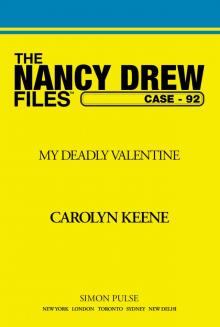 My Deadly Valentine
My Deadly Valentine The Silent Suspect
The Silent Suspect Deep Secrets
Deep Secrets False Moves
False Moves The Zoo Crew
The Zoo Crew Diamond Deceit
Diamond Deceit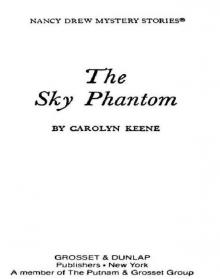 The Sky Phantom
The Sky Phantom 015 Trial by Fire
015 Trial by Fire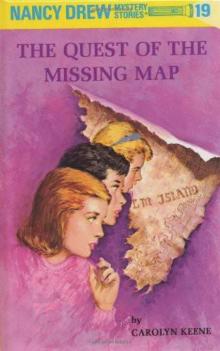 The Quest of the Missing Map
The Quest of the Missing Map Babysitting Bandit
Babysitting Bandit Don't Look Twice
Don't Look Twice Never Say Die
Never Say Die The Soccer Shoe Clue
The Soccer Shoe Clue Pool Party Puzzler
Pool Party Puzzler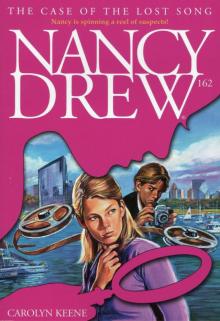 The Case of the Lost Song
The Case of the Lost Song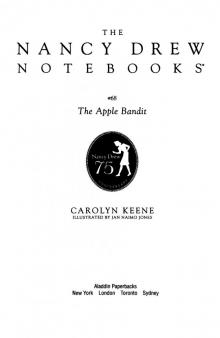 The Apple Bandit
The Apple Bandit No Laughing Matter
No Laughing Matter The Thirteenth Pearl
The Thirteenth Pearl Sabotage at Willow Woods
Sabotage at Willow Woods Butterfly Blues
Butterfly Blues Model Crime 1
Model Crime 1 The Nancy Drew Sleuth Book
The Nancy Drew Sleuth Book Mystery by Moonlight
Mystery by Moonlight Club Dread
Club Dread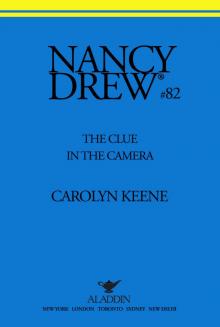 The Clue in the Camera
The Clue in the Camera 118 Betrayed By Love
118 Betrayed By Love The E-Mail Mystery (Nancy Drew Book 144)
The E-Mail Mystery (Nancy Drew Book 144) Stay Tuned for Danger: Circle of Evil
Stay Tuned for Danger: Circle of Evil Model Menace 2
Model Menace 2 California Schemin': Book One in the Malibu Mayhem Trilogy
California Schemin': Book One in the Malibu Mayhem Trilogy Zoo Clue (Nancy Drew Notebooks)
Zoo Clue (Nancy Drew Notebooks) False Pretences
False Pretences 151 The Chocolate-Covered Contest
151 The Chocolate-Covered Contest Close Encounters
Close Encounters The Emeral-Eyed Cat Mystery
The Emeral-Eyed Cat Mystery Boo Crew
Boo Crew The Message in the Haunted Mansion (Nancy Drew Book 122)
The Message in the Haunted Mansion (Nancy Drew Book 122)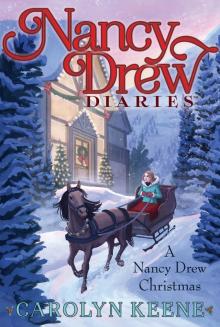 A Nancy Drew Christmas
A Nancy Drew Christmas 149 The Clue Of The Gold Doubloons
149 The Clue Of The Gold Doubloons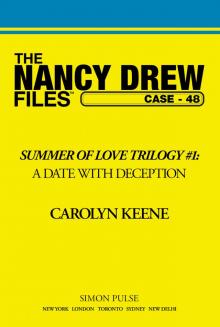 A Date with Deception
A Date with Deception 101 The Picture of Guilt
101 The Picture of Guilt The Secret in the Spooky Woods (Nancy Drew Notebooks Book 62)
The Secret in the Spooky Woods (Nancy Drew Notebooks Book 62) The Wrong Track
The Wrong Track Lights! Camera! Clues!
Lights! Camera! Clues! The Vanishing Act
The Vanishing Act Lights, Camera . . .
Lights, Camera . . . Model Suspect 3
Model Suspect 3 160 The Clue On The Crystal Dove
160 The Clue On The Crystal Dove 163 The Clues Challenge
163 The Clues Challenge Ghost Stories (Nancy Drew)
Ghost Stories (Nancy Drew) Space Case (Nancy Drew Notebooks Book 61)
Space Case (Nancy Drew Notebooks Book 61) 164 The Mystery Of The Mother Wolf
164 The Mystery Of The Mother Wolf 148 On The Trail Of Trouble
148 On The Trail Of Trouble The Walkie-Talkie Mystery
The Walkie-Talkie Mystery The E-Mail Mystery
The E-Mail Mystery Intruder (Nancy Drew (All New) Girl Detective)
Intruder (Nancy Drew (All New) Girl Detective)![The Stolen Relic [Nancy Drew Girl Detective 007] Read online](http://i1.bookreadfree.com/i2/04/11/the_stolen_relic_nancy_drew_girl_detective_007_preview.jpg) The Stolen Relic [Nancy Drew Girl Detective 007]
The Stolen Relic [Nancy Drew Girl Detective 007] 105 Stolen Affections
105 Stolen Affections An Instict for Trouble
An Instict for Trouble 161 Lost In The Everglades
161 Lost In The Everglades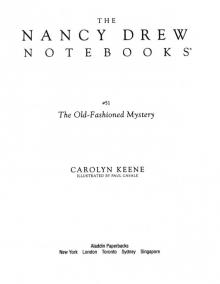 The Old-Fashioned Mystery
The Old-Fashioned Mystery Perfect Plot
Perfect Plot